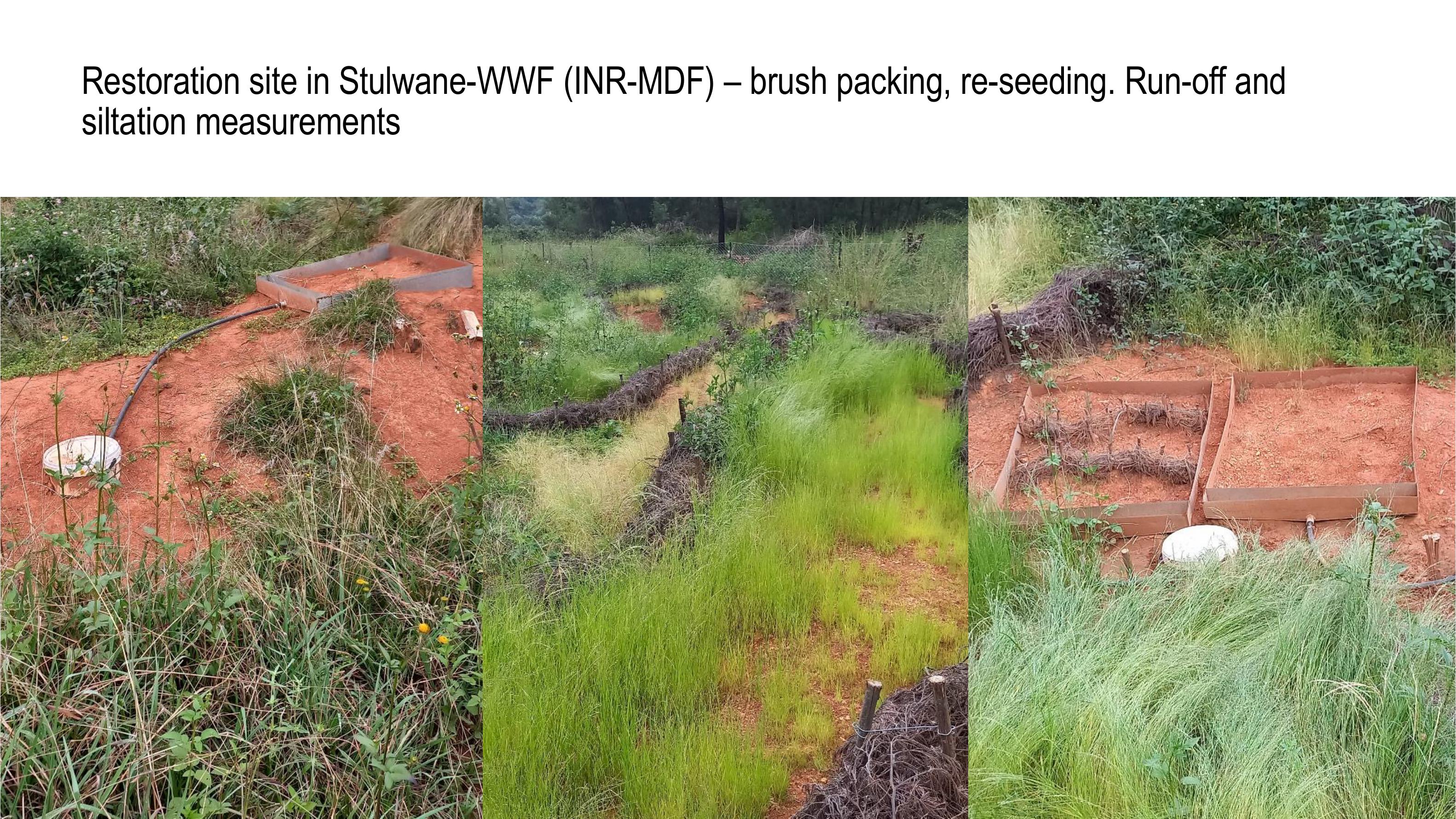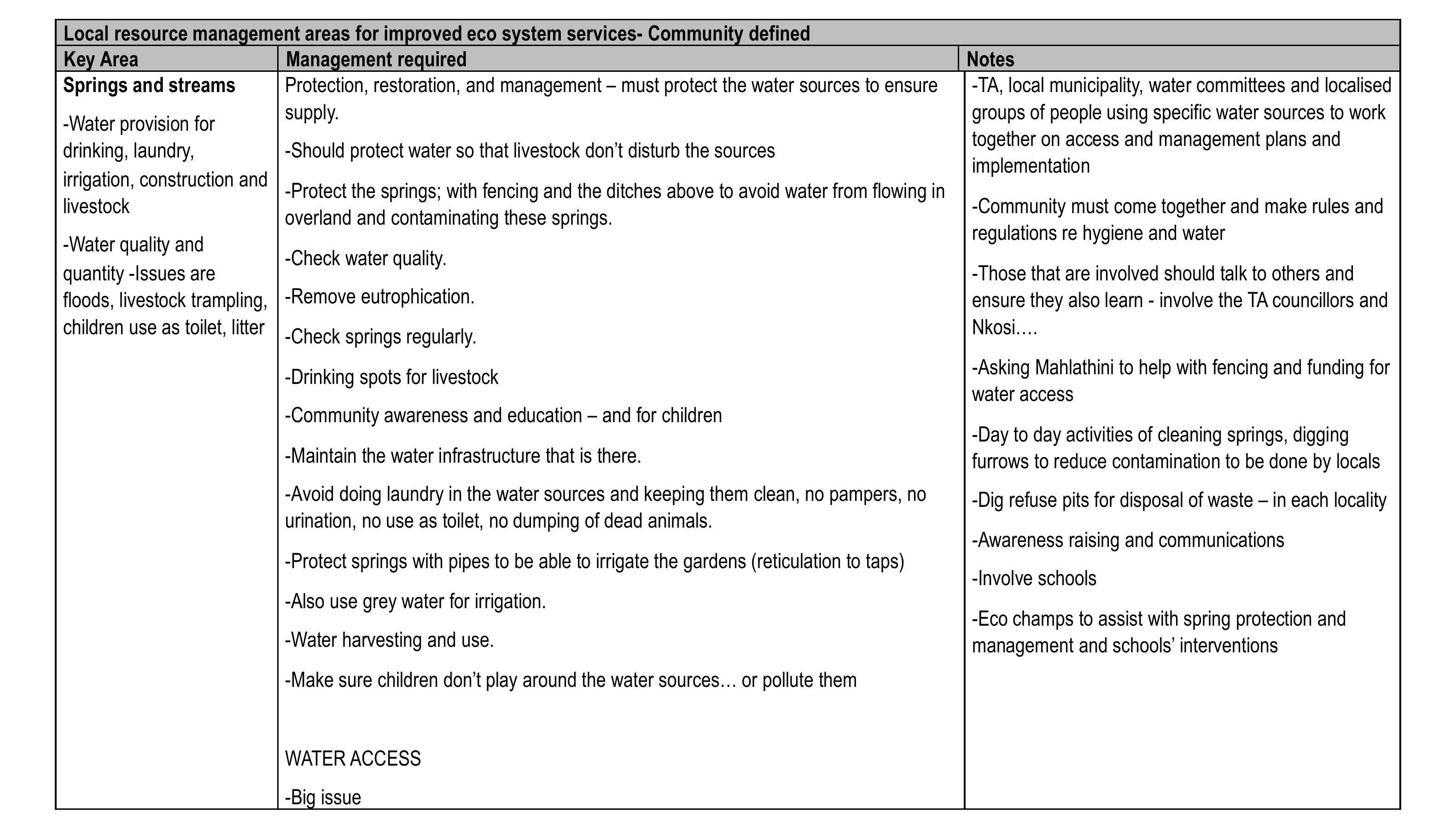
Erna’s slides

CH 2: ASSESSMENT OF RAINFALL AND WATER
QUANTITY PATTERNS OVER TIME
PARTI:ENHANCING THE KNOWLEDGE BASE TOWARDS A SHARED UNDERSTANDING
Outcome:
Understanding of the water resource (changes of
water quality, quantity, streamflow, recharge
potential, sediment load)
Methods:Historicaland current monitoringofclimatic and
hydrologicalobservations,hydrologicalmodelling.:
3 meteorological station (and a high altitude station outside this
area)
36 Raingauges
6 Streamflow gauges
3 ISCO water sampler
2 Spectral probes (WQuality)
1 Eddy Covariance flux tower (includes CO2)
2 Surface renewal systems
Warmingchambers
Fire disturbance records
Repeat vegetation surveys plots
MonthlyLeafArea Index
Cosmic Ray Probe
3 pits of TDR soil water probes to 1.6 m
MonthlyDivinerreadingsat18pointsthrough catchment
LiCor-8100 Soil Respiration System
Monthlymanual gasextractioncollars

Temperature
Annual mean temperature anomaly for the Mike’s Pass meteorological station

Impact of heat waves on crop production in Costone and Ezibomvini
Crop monitoring in Ezibomvini(24 Jan 2023) for
Conservation agriculture farmer level trials
Above: Maize for farmer 1 showing heat stress
Below: Maize and cover crops for farmer 2, in the
next-door homestead, on the same day.
WHY THE DIFFERENCE?
Org. C %
N %
pH
Clay %
Farmer 1
1,6
0,15
4,9
27
Farmer 2
2
0,19
5,1
43
- Innate soil qualities (higher % clay for
farmer 2)
- Increased soil organic matter ( %
Organic Carbon – 1,6% vs 2%)
- Increased nitrogen (0,15% vs 0,19%)
- Improved canopy cover for farmer 2

Rainfall
Annual (hydrological years) rainfall anomaly for the Mike’s Pass meteorological station for
the full period 1949 –2021 using a combination of in-situ gauged data and infilled data

-Local governance
-Decision-making
-Power and access
CH 5: GOVERNANCE, DECISION-MAKING, POWER
AND ACCESS
Methods: Focus group discussions,in-
depth interviews, informal conversations,
participants observations
PARTI:ENHANCING THE KNOWLEDGE BASE TOWARDS A SHARED UNDERSTANDING
Topicsoffocusgroupdiscussionswithcommunities
- Understanding of natural resource management
- Land use priorities and access to resources
- Land use practices in the past, present and future.
- Decision makers and decision making (community, local chiefs
and councillors)
- Impact of climate change on natural resources
In-depth semi-structured interviews with local authorities,
NGOs, water committee members in Costone and
Ezibomvini, and EcoChamps
- Toaddressquestionsrelatedtopowerdynamicswithinwater
governance, management, access and collaboration.

CH 5: GOVERNANCE, DECISION-MAKING, POWER
AND ACCESS
Summary of analysis
•TAs’functionalinthespheresoflandallocation
and community level conflict resolution
•Some leadership and decision making around
land use – grazing management, infrastructure
and services
•Lacking coherence in term of land use and
resource management
•Collaboration with Local municipal structures
sporadic and low
Outcomes
•Contestation of access to communal
resources, decision-making and governance
structures
•Frustration and discouragement within the
community regarding both the Induna, the TA,
the councillors, and the local chief. The
community members feel let down by their
leaders who are not effectively addressing their
needs and concerns, and instead, seem to
prioritize their own interests
•Community level informal groups and individual
decision making around resources and land use
management
•The concept of ownership has emerged, where
individuals claim resources such as land, water
sources, and trees as their own and engage in
economic transactions in these area.
Traditionalleadershipisexpectedtoprovide
democratic governance directly or through
supporting the government institutions across
all spheres within their communities, without
clear avenues, processes, structures or
finance provided to do so.
Clear need for coherent community level
management and decision making -
governance structures, which can promote
collaboration across local leadership structures
and provide a voice for disempowered
members of the community.

Overall, decision-making processes in these
communities involve a combination of collective
discussions among some selected groups of
community members, individual autonomy in certain
areas, and the involvement of the local chief and
councillor in resolving disputes and managing
resources. While there is a focus on community
participation and preserving natural resources, there
are also challenges and tensions in the relationship
between the community and certain governance
structures, as highlighted in the case of municipal
water access and the perceived lack of effective
leadership.
The conversations with community members and
observations during community engagement portray a
sense of frustration and discouragement within the
community regarding both the Induna, the TA, the
councillors, and the local chief. The community
members feelletdown by their leaders who are not
effectively addressing their needs and concerns, and
instead, seem to prioritize their own interests. The
community's relationship with both the local chief and
the councillors is strained, and their roles lack clarity
and effectiveness. These challenges within the
governance structure contribute to a growing sense of
frustration, highlighting the need for improved
leadership and communication to address the
community's needs and build trust.
Costone
•Contestationofaccesstocommunalresources,decision-making
andgovernancestructures:Overall,decision-makingprocessesin
thesecommunitiesinvolve acombinationofcollectivediscussions
amongsomeselectedgroupsofcommunitymembers,individual
autonomyincertainareas,andtheinvolvementofthelocalchief
andcouncillorinresolvingdisputesandmanagingresources. While
thereisa focusoncommunityparticipationandpreservingnatural
resources,therearealsochallengesandtensionsintherelationship
betweenthecommunityandcertaingovernancestructures. The
conceptofownershiphasemerged,whereindividualsclaim
resourcessuchasland,watersources,andtreesastheirown.
Thus,publicaccesstoresourceshasdiminished.
Traditionalleadership,insummary(fromthereport)
Traditionalleadershipisexpectedtoprovidedemocraticgovernancedirectlyorthroughsupportingthegovernment
institutionsacrossallsphereswithintheircommunities,withoutclearavenues,processes,structuresorfinance
providedtodoso.TheLocalGovernmentprocesseshavehoweverfailedinmostrespectstoprovidetheleadership,
supportandfundingrequiredforcoherentlanduse,waterandnaturalresourcesmanagement,leadingtolargely
unregulatedoveruseandmismanagementofresourcesincommunaltenureareas. Localinhabitantshavetosome
extentsteppedintothisvoidandmadetheirownarrangements,generallyclearlydesignedtoprovidepersonalbenefit
tosomeindividuals,andnoneofwhicharenecessarilysupportedlegally. Thissituationhasfurtherweakenedthe
positionofwomenandthepoorinthesecommunities.

•Thematic co-learning workshops
•Weather and climate change: graphs and discussions on impact
•Socio-ecological mapping and adaptive planning
•Map handover and implementation progress review – Local resource
management committees
•Cross visits
•Ezibomvinilearning group members to Stulwane
•Multistakeholder interactions
•NDC project presentations
•Field visit
PARTII:CO-LEARNING FOR SUSTAINABLE MANAGEMENT OF COMMUNITY RESOURCES

Social-ecological mapping in
Ezimbomvini

Social-ecological mapping in Costone

Local resource management areas for improved eco system services
- Community defined
Key Area
Management required
Notes
Grazing areas
(Amadlelo)
-
Livestock feed and water,
firewood, medicinal plants,
Restoration and management
.
-
Clear Lantana and use poison after cutting to stop regrowth
-
Rotational grazing
-
Control wildfires and make firebreaks. Storage drums for emergencies with fire one can
use
-
Explore financial benefit – grant/incentive mechanisms
-
Monitor and manage nutrition of veld (erosion control, overgrazing control, removal of
poisonous weeds, re
-seed of palatable species)
-
Awareness raising in the community and for livestock owners.
-
Eco-champs to do clearing
-
Dip tank committees and livestock associations
-
Better community collaboration with dip tank committee
as well as TA and councillors
-
Community workdays
- Clearing of Lantana in Ezibomviniand Costone.
- Moving gates and fixing fences in Costonegrazing
area
- Workshop presented by Working on Fire team in
the uThukela area- re firebreaks and fire
management
CH 8: CO-DESIGNED INNOVATIONS AND ACTIONS

Erosion control
-Toensur eavailabilityand
quality of water and soil
resources
Restoration
-
Awareness raising and outline ofresponsible actionsto enforce
-
Avoid expanding of minor erosion into dongas.
-
Prevent siltation and pollution.
-
Allow re-vegetation, naturally or through re-seeding
-
Prevent run-off
-
Check dams, brush packs, stone packs,
-
Prevent livestock from causing further damage
-
Control wildfire- make fire breaks
Storage drums for emergencies with fire one can use
-
TA andlivestockcommitteestoundertakesome
actions
-
Eco champs to assist
-
Some actions and contributions from community as a
whole (e.g. loan of tractors, small financial
contributions
-
External support
-
Continued support from UKZN and MDF in mapping,
planning, proposal development, community structures
and management
Alien trees
-
Eucalyptus, poplar, and
wattle plantations, and
patches
Small changes
-
Promote better management by ‘owners’
-
Cut down and poison lantana and encroaching poplars
-
Ensure management of wattle patches
-
Remove trees from water sources and streams in all cases
-
TA,Nkosiand‘owners”encouragedtoundertake
management activities as trees are useful in the
community and cannot just be cleared.
Local resource management areas for improved eco system services
- Community defined
Key Area
Management required
Notes

Stone packs and stone lines by eco champs in
Ezibomviniand Community in Cosotone

Community based clearing of wattle in Costone

Restoration site in Stulwane-WWF (INR-MDF) – brush packing, re-seeding. Run-off and
siltation measurements

Springs and streams
-
Waterprovisionfor
drinking, laundry,
irrigation, construction and
livestock
-
Waterqualityand
quantity
-Issues are
floods, livestock trampling,
children use as toilet, litter
Protection, restoration, and management
– must protect the water sources to ensure
supply.
-
Should protect water so that livestock don’t disturb the sources
-
Protect the springs; with fencing and the ditches above to avoid water from flowing in
overland and contaminating these springs.
-
Check water quality.
-
Remove eutrophication.
-
Check springs regularly.
-
Drinking spots for livestock
-
Community awareness and education – and for children
-
Maintain the water infrastructure that is there.
-
Avoid doinglaundry in the watersources andkeeping them clean, no pampers, no
urination, no use as toilet, no dumping of dead animals.
-
Protect springs with pipes to be able to irrigate the gardens (reticulation to taps)
-
Also use grey water for irrigation.
-
Waterharvestinganduse.
-
Make sure children don’t play around the water sources… or pollute them
WATER ACCESS
-
Big issue
-TA,localmunicipality,watercommitteesandlocalised
groups of people using specific water sources to work
together on access and management plans and
implementation
-Community must come together and make rules and
regulations re hygiene and water
-
Those that are involved should talk to others and
ensure they also learn
-
involve the TA councillors and
Nkosi….
-
Asking Mahlathini
to help with fencing and funding for
water access
-
Day to day activities of cleaning springs, digging
furrows to reduce contamination to be done by locals
-
Dig refuse pits for disposal of waste – in each locality
-
Awareness raising and communications
-
Involve schools
-
Eco champs to assist with spring protection and
management and schools’ interventions
Local resource management areas for improved eco system services
- Community defined
Key Area
Management required
Notes

WaterqualitytestinginEzibomviniand Costone, including river ecology, mini SASS and E.coli.
Cleaning of streambeds by community in Costone

Spring protection and reticulation in Costone:Community and eco-
champs

Planning stream abstraction for multi purpose water supply – Costone –July-Sept 2023

Wetlands
(Amacaphuza),
-
Reeds (incema)
-Food and water for cattle,
also in winter
-
Medicinal plants
-
Fire retardant
-
Runoff and flood water
management
-
Improved water quality
-
Fertile soils with
earthworms
Small management changes to manage condition of wetlands.
-
Fencing to ensure good condition and make drinking troughs for livestock
-
Awareness raising on wetlands functionsand services
-
Replanting important species into wetlands; then someone needs to police this and
ensure people don’t just harvest everything
-
Protection and restoration of important medicinal species for sale: Stop people with
big bags who come in and take for selling
-
Avoid pigs coming in astheymessthingsup
-
Avoid fires and burning
-
Livestock inclusion managed e.g. –allow them in at certain times only. Or maybe
make camps and move them. Or allow them to graze on the edges. Or cut and carry
feed.
-
TA involvementand‘landowners’inwetlandareasto
outline rules and responsibilities
-
Community as a whole to follow these
-
Local water and land use committees to undertake
specific actions related to water access and
management
-
Issues around rights around use of water and
important medicinal plants need further interventions
-
Suggestion: talk to livestock association then bring
their comments and suggestions to the water
committee to continue the conversation and include all
Local resource management areas for improved eco system services
- Community defined
Key Area
Management required
Notes
No interventions as yet around wetlands – requires whole community
commitment as well as intervention by traditional authorities for
changing rules of use and management

Preparation and construction of spring protection and reticulation in Costone.

PARTII:CO-LEARNING FOR SUSTAINABLE MANAGEMENT OF COMMUNITY RESOURCES
CH 9: DECISION SUPPORT FRAMEWORKOutcome:
A frameworktosupportco-designed decision-making based on
co-learning for sustainable management of community resources
Climate Resilient Agriculture (CRA) learning groups and relationship building with local and external stakeholder


Theoveralloutcomesofsuchasprocessareexpectedtobe:
- Improvedparticipatorydecisionmakingtosupportimplementationandinnovation.
- Improvedgovernance - newcommunity-basedstructures
- Improvedgovernance - improvedrulesandlogisticswithincommunity-basedstructures.
- Improvedgovernance - coherentcollaborationwithstakeholdersandroleplayers.